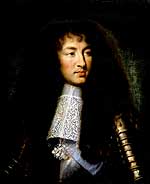 |
 |
 |
 |
 |
 |
 |
 |
 |
 |
 |
 |
 |
 |
 |
 |
 |
 |
 |
 |
 |
 |
|
|
|
The Kings of France were responsible for the speed or slowness
of the development of their New-France possessions. Francois 1er(who reigned from 1515 to 1547) was eager
to see the new world evolve and grow, but by the time
Louis XIV came into power, in 1643, at five years of age,
the King was made progressively aware that France indeed
needed large amounts of monies to get out of their bankrupties and later on
to be able to get the expected luxuries
which would become available at the Court of France, during his reign. The Colonies were drained of their revenues (furs, wood)
without the rewards which could have brought greater freedom of action. Nowadays, the companies that really prosper have plans to re-invest some of their profits in their fold and contingency plans to incorporate new funding in times of drought. The people in New France were simply drained of their resources, in a "free-for-all" as it were, each higher level becoming more greedy and grasping. The "little" people were effectively denied proper rewards for their hard work, so many also stole as much as they could from the government, on a small scale, but nevertheless, the fabric of society was often shoddy and full of holes. Naturally, there were exceptions. There is always an Hershey once in a while.
Nevertheless, in la "Nouvelle-France", the average person did their best to make a profit somewhere,
and consequently a certain lack of expansion was felt. Louis XIV (1638-1715), king of France (1643-1715), was born at Saint-Germain-en-Laye.
Louis was the third monarch of the Bourbon family.
He ruled for 72 years, the longest reign in European history.
He was the unexpected child of King Louis XIII and Anne of Austria, who had not had children in their 22-year marriage.
He was christened Louis Dieudonné (literally, “gift of God”).
In 1643, before his fifth birthday, his father died, and Louis inherited the crown of France, which was internally divided, militarily exhausted, and nearly bankrupt.
While Louis was a child, his mother served as regent, ruling France in his place.
She was assisted by Jules Cardinal Mazarin, the Italian financier who had been the principal minister of Louis XIII.
Mazarin had guided the nation through the later stages of the Thirty Years' War (1618-1648).
Excerpts from
the Chateau de Versailles website can be found under "Historical Figures" at
www.chateauversailles.fr/EN/210.asp and Excerpts from
the GIROUARD ACADIAN Website can be found at
www.girouard.org/cgi-bin/page.pl?file=louis14&n=9 Young King's Feelings of Taking Revenge
Louis XIV was born at the royal chateau in Saint-Germain-en-Laye.
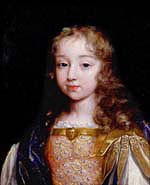
Portrait Louis XIV at 10 yrs old.
He was only five when he became king on the death of his father, Louis XIII. The regency, confided to his mother, Anne of Austria, was marked by a period of rebellion known as the Fronde (1648?1653), led first by the nobility and later by the urban commoners. The boy felt both humiliated by arrogant nobles and threatened by the people of Paris and would never forget it. |
|
|
The King of France Governs Alone
Louis married Marie-Thérèse, out of diplomatic necessity, she was the eldest daughter of King Philip IV of Spain.The marriage was arranged via a treaty that explicitly excluded Marie's heirs from inheriting the Spanish crown once Philip had paid her dowry. However, the full dowry was never paid. Consequently, Louis refused to relinquish his family's claim to the Spanish inheritance, a claim that was to influence French policy later in Louis's reign.So in 1660 Louis XIV married Maria Theresa, Infanta of Spain. The following year, on the death of his godfather and prime minister, Cardinal Mazarin, the 23-year-old monarch announced that he himself would govern. No one believed him. Yet he insisted on convening a council on a daily basis, from which he excluded grand nobles, surrounding himself instead with ministers who owed him all. |
|
|
|
'The Century of Louis XIV'
The first twenty years of the king's personal reign were the most brilliant. After Mazarin died in 1661, Louis declared that henceforth he would rule France without a chief minister, something no French king had done in living memory. He intended to rule as an absolute monarch, believing that his power as king was derived from God and that he was responsible to God alone. He took the sun as his emblem and connected himself to its radiant image. Portraits, woodcuts, and engravings of the king portrayed as the Greek sun god Apollo poured from Parisian workshops.
With his minister Colbert, he carried out the administrative and financial reorganization of the kingdom, as well as the development of trade and manufacturing. With the Marquis de Louvois, he reformed the army and racked up military victories. Finally, Louis encouraged an extraordinary blossoming of culture: theatre (Molière and Racine), music (Lully), architecture, painting, sculpture, and all the sciences (founding of the royal academies).
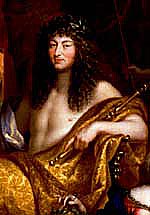
LOUIS XIV
These accomplishments would be depicted on the ceiling of the Hall of Mirrors. This "Galerie des Glaces" erected to the glory of Louis XIV and now the chief masterpiece of Versailles, was begun in 1678 when the chateau became the official residence, disrupting the order of the salons known as the Apartment of the Planets. On the signing of the Treaty of Nijmegen, which represented the high point of his reign, Louis XIV ordered Le Brun to depict his government's accomplishments on the ceiling of the hall. Le Brun designed thirty compositions, framed by stucco-work, showing the monarch in various guises: Roman emperor, great administrator of the kingdom, and victor over foreign powers.
|
|
|
The Sun Myth
Louis XIV chose the sun as his emblem. The sun was associated with Apollo, god of peace and arts, and was also the heavenly body which gave life to all things, regulating everything as it rose and set. Like Apollo, the warrior-king Louis XIV brought peace, was a patron of the arts, and dispensed his bounty.
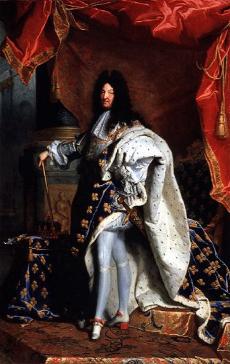
Portrait of Louis XIV, 1701,
by Hyacinthe Rigaud
The regularity of his work habits and his ritual risings and retirings (levee and couchee) were another point of solar comparison. Throughout Versailles, decoration combines images and attributes of Apollo (laurel, lyre, tripod) with the king's portraits and emblems (the double LL, the royal crown, the sceptre and hand of justice). The Apollo Salon is the main room of the Grand Apartment because it was originally the monarch's state chamber. The path of the sun is also traced in the layout of the gardens. |
|
|
The Master of Versailles
The enchanting chateau of the king's youth became the official residence of the court and government of France on May 6, 1682. By providing enough space to house the courtiers, the chateau and its outbuildings helped to domesticate the nobility. Under the king's ever watchful eye, great lords no longer plotted. They remained with the army or at court, ready to please and serve. Intimidating, majestic, and fully informed by his spies, the king controlled everything. If he was heard to say of you, "I know him not," you were doomed forever. |
|
|
'L'Etat, c'est moi'(I am the State!)
Louis XIV immersed himself completely in what he called 'the trade of kingship', identifying himself totally with the state in the famous phrase, 'I am the State'. Devoting himself to his people, he put himself constantly on public show. Versailles was open to everyone, not just courtiers. Access to the monarch was governed by court ceremonial, and the immutable rites of the Sun King's day drove the entire 'court mechanism'. Elsewhere, the wheels of the new administration established during the early part of the reign ran smoothly: at the centre, king and council decided; in the provinces, intendants executed his orders.
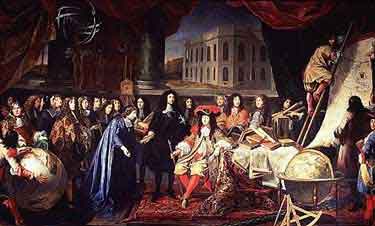
Louis XIV with Colbert
Portrait by Henri Testelin
|
|
|
The Most Christian King
Monarch by divine right, the king was God's lieutenant on earth. During his coronation, he swore to defend the Catholic faith. To honour this oath and preserve the religious unity of his kingdom, Louis XIV launched the struggle against Jansenists at the Port-Royal monastery, and persecuted Protestants. Forced conversions and the emigration of 200,000 Protestants ultimately led him in 1685 to rescind of the Edict of Nantes (which had decreed religious tolerance). |
|
|
|
Louis XIV and The Fires of Love
Marie Mancini, Louise de la Vallière, Madame de Montespan and several other beauties at court won the king's heart. In order to dazzle them, he organized extraordinary festivities that wonderfully bedecked the original (if slightly enlarged) Louis XIII chateau. These royal love affairs yielded many offspring, whom Louis XIV later legitimized or betrothed to other members of the royal family.
Around 1680 'L'histoire des poisons' (story of the poisons) will rock French society after Louis XIV ordered his Lieutnant La Reynie to investigate the death of many by unknown poisons, as first shown by Madame de Brinvilliers' actions but cascading into the higher nobility and the Court.
|
|
|
A CHANGE OF HEART Once young and gay,
the court became more austere.

Madame de Maintenon Festivities became rarer as war sapped finances;
love affairs faded because Madame de Maintenon
(whom the king secretly married immediately after the Queen's death in 1683)
required strict, Christian, constant devotion. The generation that contributed to the glory of the Sun King also gave way to a new entourage who executed the designs of absolutist government Louis XIV.
Madame de Maintenon
(FRANCOISE D'AUBIGNE)
would become the second and last wife of King Louis XIV of France. |
|
|
| The Marchioness of Maintenon, la marquise de Maintenon, was an orphan and she married her guardian, a poet, at 16. He died leaving her with some debts and to survive she did the only thing which an educated lady of her time could do without a loss of face: teach. She became a governess in the households of the French Nobility . In 1669 she started teaching two of the sons' of Mme de Montespan (the King's official mistress) and Louis XIV of France, "le Roi-Soleil", of the Chateau de Versailles. The King had seven children from Mme de Montespan which he would legitimize in 1673. |
|
|
| Mme de Montespan had been the lady-in-waiting of the Queen Maria-Theresa and after she was granted a divorce from her ex-husband she became the Official Mistress of the King. She was eventually supplanted by Mlle de Fontange and then, perhaps, by Mme de Maintenon. |
|
|
|
When the Queen died in 1684, King Louis XIV secretly married Mme de Maintenon and it was a few years before it became public, but they remained together until his death in 1715. She was judged harshly by the Ministers of the King because of her "undue" influence on the King on matters of State, mostly religious tolerance for the many Protestants still living in France since Henri IV. She had Mme de Guyon released after 7 years in prison (house-arrest) because of her Quietist teachings which had been disturbing to the Pope.
* * * * * * * * *
Link to the MISTRESSES of the FRENCH KINGS
Les Maitresses Royales de Versailles
Madame de Pompadour, du Barry, de la Vallieres, Montespan, etc... LINK to the CHATEAU de VERSAILLES |
|
|
|
|
|
| She had founded the famous school of St.Cyr for the empoveriched noble-born girls, St-Cyr, which provided them with an opportunity to get the education expected when they would marry at their level or beyond, and when the King died, she retired there. On the domestic front, Louis strengthened the central government's control over the diverse regions of France, incorporating his territorial gains into a united state. On the other hand, he provoked controversy when he restored Catholic religious unity by revoking the Edict of Nantes and repressing Protestantism. Unfortunately many of Louis's policies, both domestic and foreign, caused great hardship to ordinary people, many of whom suffered starvation, fled their homeland, or lived in terror of persecution.
Louis XIV's reign was so long(72 years) that it was his grand-son Louis XV who became the next King. Later on still, in 1789, when the French Revolution came it was Louis XV's second son, Louis XVI and Marie-Antoinette who would die on the Guillotine.

Louis XIV at 67 - Wax by A.BenoistBACK TO DANIELLE'S GENEALOGY WEBSITEat www.geocities.com/daniellla.geo
LINKS
Back To Danielle's INDEX
List of French Kings
Liens sur l'histoire du Canada et de l'Acadie
pages.infinit.net/lej/index.htm
Link to more info on Pierre Chauvin
pages.infinit.net/lej/diction/chauvin.htm,
Find a Grave of a famous person
Liens sur le Patrimoine
par "Culture et Communications Québec"
www.mcc.gouv.qc.ca/pamu/patrimoi.htm
TANGUAY Reference book
www.bnquebec.ca/numtxt/3957-1-(266-375).pdf
HISTORICA Canada
www.histori.ca/default.do;jsessionid=B6B7750FCDA8FB1072987E949019A6D4
LINK to CANADIAN GENEALOGICAL SOURCES
www.archives.ca/02/020202_e.html
Acadian sources
Birth, marriage, death, divorce and adoption records
Census records
Citizenship (naturalization) records
Employment Records
Home children
Immigration records
Land records
LI-RA-MA (Russian Consular records)
Loyalist sources
Métis records
Military records
Newspapers and Obituaries
North West Mounted Police (R.C.M.P.)
School Records
Wills and estate records
* * * * * * * * * * * * * *
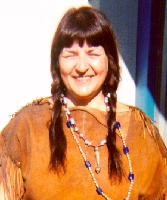
Danielle - Celebrations 2000
* * * * * * * * * * * * * *
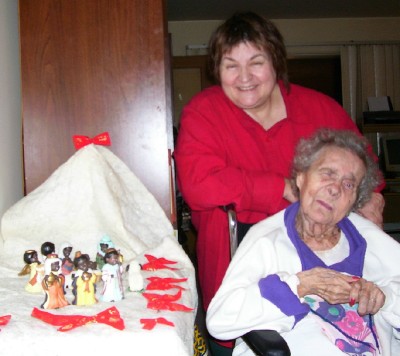
Danielle et Olga Obry LeMyre (1916-2006)
Thank you for your visit
Danielle - ddlemyre@yahoo.com -
514 236-0244












|
|
|
|
|
